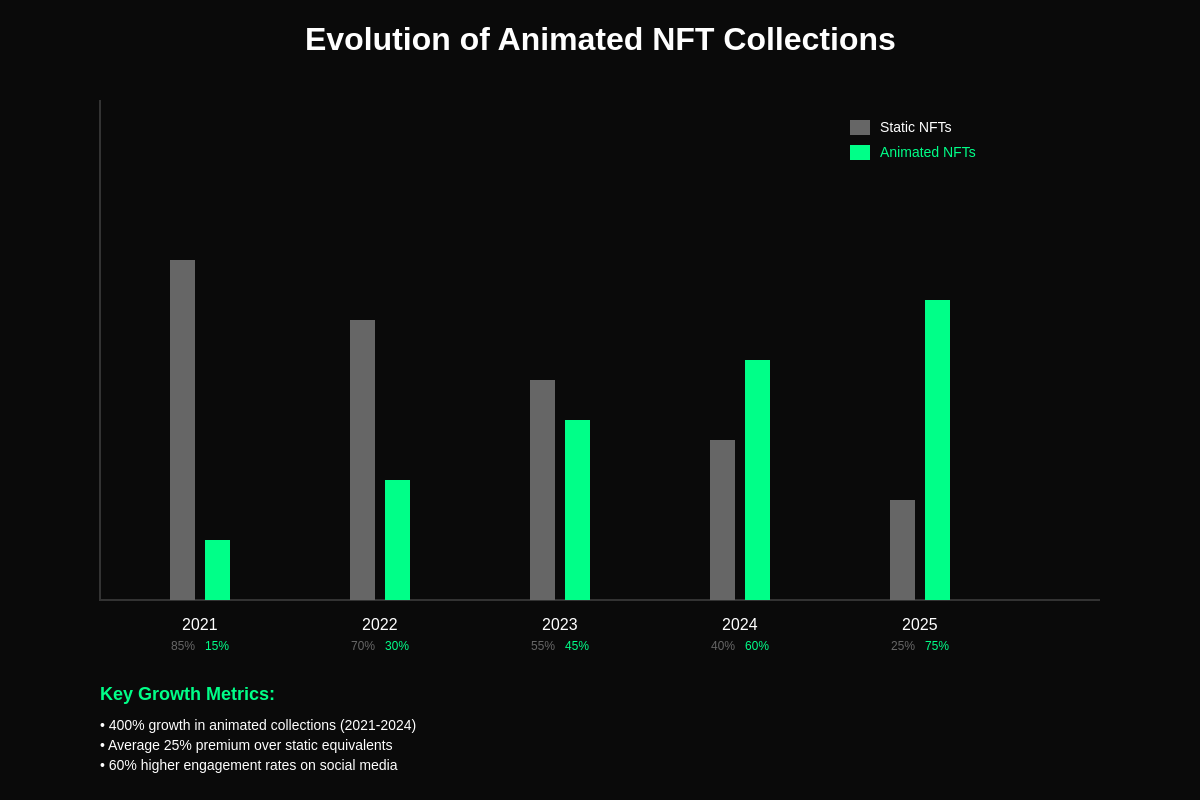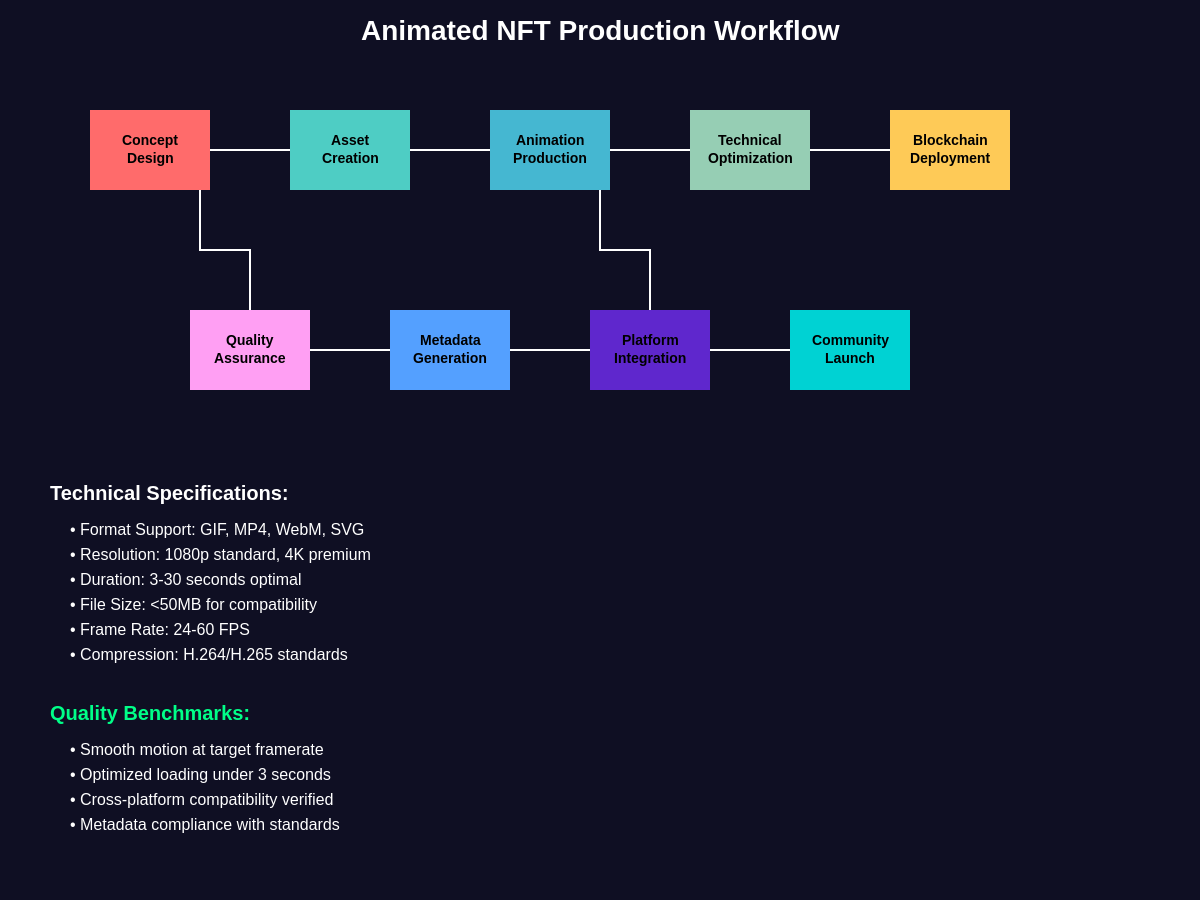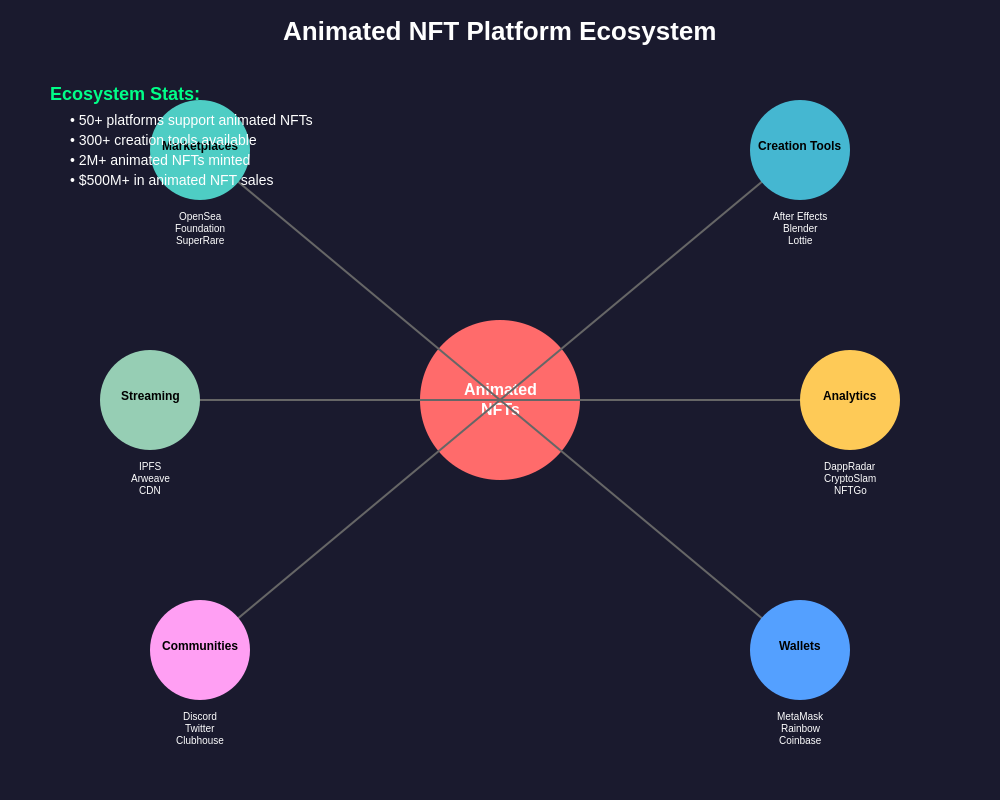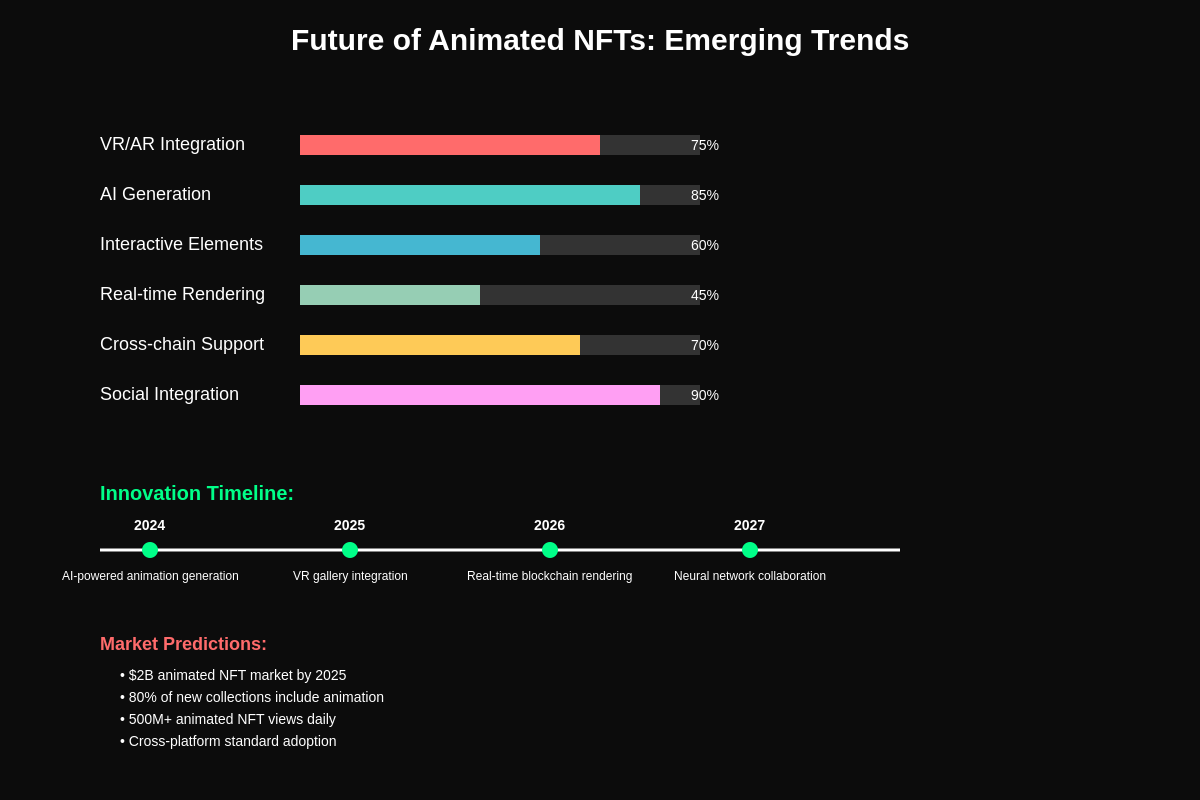The Evolution Beyond Static Digital Art
The non-fungible token landscape has undergone a revolutionary transformation with the emergence of animated NFTs, representing a paradigm shift from static digital images to dynamic, motion-based collectibles that capture movement, narrative, and temporal artistic expression. This evolution has fundamentally changed how creators approach digital art creation, how collectors perceive value in digital assets, and how blockchain technology facilitates the ownership and trading of time-based media content.

Animated NFTs encompass a broad spectrum of digital motion graphics including looping GIFs, complex video sequences, interactive animations, and algorithmically generated motion patterns that create entirely new categories of digital collectibles. The technical infrastructure required to support animated NFTs presents unique challenges related to file size optimization, streaming capabilities, metadata management, and long-term preservation of motion-based content that differs significantly from traditional static image NFTs.
The artistic possibilities enabled by animated NFTs have attracted creators from diverse backgrounds including traditional animators transitioning from film and television, graphic designers exploring motion graphics, digital artists experimenting with new mediums, and technologists developing innovative approaches to generative animation. These creators are pushing the boundaries of what constitutes collectible digital art while establishing new aesthetic standards and technical benchmarks for animated NFT collections.
Historical Context and Early Pioneers
The roots of animated NFTs can be traced back to the earliest NFT experiments on blockchain platforms, with pioneering creators recognizing the potential for motion-based digital art long before the infrastructure and market demand fully supported such content. Early animated NFT projects faced significant technical limitations including blockchain storage constraints, display compatibility issues, and market uncertainty about collector interest in motion-based digital assets.
CryptoPunks, while primarily known for static pixel art, included some early experiments with animated variations that demonstrated the potential for motion graphics in the NFT space. These early animated punks, though limited in their motion complexity, established important precedents for how animated content could be integrated into existing NFT frameworks and how collectors might respond to dynamic digital collectibles.
The launch of platforms specifically designed to support video and animated content marked a crucial turning point in animated NFT adoption, with marketplaces developing specialized infrastructure for hosting, streaming, and trading motion-based digital assets. These platforms addressed critical technical challenges including file compression, loading optimization, and cross-device compatibility that were essential for mainstream animated NFT adoption.
Art Blocks emerged as another significant force in animated NFT development, with generative artists creating algorithmic animation systems that produce unique motion patterns for each minted token. These generative animated collections demonstrated how programming concepts could be applied to create scalable animated art systems that maintain uniqueness and artistic integrity across large collection sizes.
The success of profile picture (PFP) collections created demand for animated versions of popular static collections, leading to the development of derivative animated projects and official animated releases from established NFT brands. This trend highlighted the market appetite for motion-based versions of familiar NFT properties and established business models for converting static collections to animated formats.
Technical Infrastructure and Blockchain Considerations
The technical implementation of animated NFTs requires sophisticated infrastructure that addresses unique challenges related to file storage, bandwidth requirements, compression algorithms, and cross-platform compatibility. Unlike static images that can be easily stored and displayed across various platforms, animated NFTs require specialized handling for motion data, timing information, and interactive elements that define the animated experience.

Blockchain storage limitations necessitate creative approaches to animated NFT data management, with most projects utilizing distributed storage systems like IPFS (InterPlanetary File System) to host animation files while storing only metadata and hash references on-chain. This hybrid approach balances the immutability and verifiability of blockchain technology with the practical requirements of storing and serving large animated files efficiently.
File format standardization has become a critical consideration for animated NFT projects, with creators navigating trade-offs between quality, file size, compatibility, and feature support across different formats. GIF files offer universal compatibility but limited color depth and compression efficiency, while MP4 videos provide superior compression and quality but may face compatibility issues across different NFT platforms and wallet applications.
The emergence of specialized animated NFT platforms has driven innovation in compression algorithms, streaming protocols, and interactive features that enhance the animated NFT experience beyond simple video playback. These platforms implement advanced techniques including adaptive bitrate streaming, progressive loading, and interactive overlay systems that create more engaging and technically sophisticated animated collectibles.
Smart contract considerations for animated NFTs often include additional metadata fields for animation properties, loop counts, duration information, and interactive parameters that static NFTs do not require. These enhanced smart contracts enable more sophisticated trading mechanisms, royalty calculations, and programmatic interactions that leverage the unique properties of motion-based digital assets.
Scalability challenges for animated NFT platforms include bandwidth management for simultaneous streaming of multiple animated assets, content delivery network optimization for global accessibility, and database architecture for efficient storage and retrieval of complex animation metadata. These technical considerations significantly impact user experience and platform performance as animated NFT adoption continues to grow.
Market Dynamics and Collector Behavior
The animated NFT market exhibits distinct characteristics that differentiate it from static NFT collections, with collectors demonstrating different valuation criteria, holding patterns, and engagement behaviors when interacting with motion-based digital assets. The psychological impact of animation creates stronger emotional connections between collectors and their animated NFTs, often resulting in lower turnover rates and higher attachment to specific pieces within collections.
Pricing dynamics for animated NFTs typically reflect premiums over comparable static collections, with the additional production complexity, technical requirements, and perceived artistic value of motion graphics commanding higher valuations in secondary markets. However, this premium varies significantly based on animation quality, technical sophistication, creator reputation, and the specific implementation of motion elements within the collection.
TradingView charts reveal distinct trading patterns for animated NFT collections, with volume spikes often corresponding to social media viral moments where the animated elements generate significant engagement and sharing. The memetic potential of animated NFTs creates unique marketing advantages that can drive rapid adoption and community growth around specific collections.
The emergence of animated NFT portfolio management tools reflects the growing sophistication of collectors who specifically seek motion-based digital assets as a distinct category within their broader NFT holdings. These specialized tools address unique requirements for displaying, organizing, and analyzing animated collections that traditional NFT portfolio managers cannot adequately support.
Social proof and community engagement around animated NFT collections often center on the shareability and viral potential of motion graphics content, with successful animated collections frequently becoming social media phenomena that extend far beyond traditional NFT collector communities. This broader appeal can drive mainstream adoption but also creates volatility as mainstream interest fluctuates.
The development of animated NFT lending and financial services reflects growing institutional recognition of motion-based digital assets as a legitimate asset class with distinct risk and return characteristics. These services must address unique technical challenges related to animation validation, authenticity verification, and value assessment that differ significantly from static NFT financial products.
Creative Technologies and Production Workflows
Modern animated NFT creation encompasses a diverse ecosystem of creative technologies ranging from traditional animation software adapted for NFT production to purpose-built tools specifically designed for blockchain-native motion graphics creation. Professional animators utilize industry-standard software like After Effects, Cinema 4D, and Blender to create high-quality animated content, while newer tools focus on streamlined workflows optimized for NFT specifications and blockchain deployment.
Generative animation systems represent a particularly innovative approach to animated NFT creation, with creators developing algorithmic systems that generate unique motion patterns, timing variations, and visual effects for each token in a collection. These systems often incorporate randomization algorithms, physics simulations, and procedural generation techniques that create scalable animation production workflows capable of generating thousands of unique animated pieces.
The integration of artificial intelligence and machine learning technologies into animated NFT production has enabled new creative possibilities including style transfer animations, AI-generated motion patterns, and automated lip-syncing for character-based collections. These AI-powered tools democratize animated content creation by reducing the technical barriers that traditionally limited animation production to specialized professionals.
Real-time rendering technologies borrowed from gaming and interactive media have found applications in animated NFT creation, enabling creators to develop responsive animations that react to blockchain data, market conditions, or user interactions. These dynamic animated NFTs represent a new category of responsive digital art that blurs the lines between collectibles and interactive experiences.
Collaborative production workflows for animated NFT collections often involve distributed teams of artists, animators, developers, and community managers working together across global locations. These collaborative approaches require sophisticated project management tools, version control systems, and quality assurance processes that ensure consistency and technical standards across large animated collections.
The emergence of no-code animation platforms specifically designed for NFT creators has lowered barriers to entry for animated NFT production, enabling artists without traditional animation experience to create motion-based collectibles using template-based systems and simplified user interfaces. These platforms often integrate directly with NFT marketplaces and blockchain deployment tools to streamline the entire creation and launch process.
Platform Ecosystem and Infrastructure Development
The animated NFT ecosystem has evolved to include specialized platforms that address the unique technical and user experience requirements of motion-based digital collectibles, with each platform developing distinct approaches to content hosting, display optimization, and community features that cater to animated NFT creators and collectors.

Marketplace differentiation in the animated NFT space often centers on technical capabilities including streaming quality, loading performance, mobile compatibility, and interactive features that enhance the viewing experience for motion-based content. Leading platforms invest heavily in content delivery networks, compression technologies, and adaptive streaming systems that ensure high-quality animated NFT display across diverse devices and network conditions.
The development of animated NFT creation tools integrated directly into marketplace platforms has streamlined the production and deployment process for creators, eliminating many technical barriers that previously required specialized knowledge of blockchain technology and file optimization. These integrated tools often include animation templates, automated compression, and metadata generation systems that simplify animated NFT production workflows.
Cross-platform compatibility remains a significant challenge for animated NFT infrastructure, with different marketplaces, wallets, and display applications supporting varying animation formats, quality levels, and interactive features. Standardization efforts within the industry aim to establish common protocols and formats that ensure animated NFTs maintain their intended appearance and functionality across different platforms and viewing contexts.
The emergence of virtual gallery spaces and metaverse platforms specifically designed for animated NFT display has created new opportunities for collectors to showcase their motion-based digital assets in immersive environments. These platforms often feature specialized display systems, lighting effects, and interactive elements that enhance the presentation of animated collections beyond traditional marketplace interfaces.
Analytics and data visualization tools for animated NFT platforms must address unique metrics related to view duration, animation completion rates, interaction patterns, and engagement depth that are not relevant for static NFT collections. These specialized analytics systems provide creators and collectors with insights into how animated content performs and resonates with audiences in ways that traditional NFT metrics cannot capture.
Legal and Intellectual Property Considerations
The legal landscape surrounding animated NFTs presents complex challenges related to copyright, trademark, and intellectual property rights that differ significantly from static digital art due to the temporal and often derivative nature of animated content. Animation frequently incorporates elements such as music, sound effects, character designs, and narrative elements that may be subject to separate intellectual property protections requiring careful legal consideration.
Copyright implications for animated NFTs often involve multiple layers of protection including the underlying animation sequences, any incorporated audio elements, character designs, and the overall creative work as a cohesive piece. Creators must navigate these various protection layers while ensuring they have appropriate rights to all elements incorporated into their animated NFT collections.
The use of copyrighted material in animated NFT projects, whether through sampling, homage, or parody, creates legal risks that require careful analysis of fair use provisions, licensing requirements, and potential infringement claims. The global nature of NFT markets complicates these considerations as different jurisdictions apply varying standards for copyright protection and fair use exceptions.
Licensing frameworks for animated NFT collections must address unique considerations related to display rights, reproduction permissions, and derivative work creation that are particularly relevant for motion-based content. These licensing agreements often include specific provisions for social media sharing, commercial usage, and adaptation rights that reflect the viral and shareable nature of animated content.
The integration of artificial intelligence and machine learning technologies in animated NFT creation raises novel legal questions about authorship, originality, and ownership when AI systems generate or significantly contribute to the creative output. These questions become particularly complex when AI systems are trained on copyrighted material or when the resulting animations incorporate recognizable elements from existing works.
Trademark considerations for animated NFT collections extend beyond visual elements to include motion patterns, animation styles, and interactive features that may serve as source identifiers for specific creators or collections. The protection of these animated trademarks requires specialized legal strategies that account for the dynamic nature of the protected elements.
Economic Models and Revenue Streams
The economic landscape for animated NFT collections encompasses diverse revenue models that leverage the unique properties of motion-based digital assets, with creators and platforms developing innovative approaches to monetization that extend beyond traditional primary and secondary sales mechanisms.
Primary sales strategies for animated NFT collections often incorporate tiered pricing structures that reflect animation complexity, production costs, and anticipated market demand, with higher-tier animated pieces commanding significant premiums over comparable static alternatives. These pricing strategies must balance production economics with market accessibility to ensure broad collector participation while rewarding the additional creative and technical investment required for animated content.
Secondary market dynamics for animated NFTs frequently exhibit different patterns than static collections, with certain animated pieces achieving viral status that drives dramatic price appreciation independent of traditional collectible valuation metrics. The memetic potential of animated content creates unpredictable value drivers that can significantly impact secondary market performance.
Royalty structures for animated NFT collections often include enhanced terms that reflect the ongoing technical infrastructure costs associated with hosting and serving motion-based content, with creators negotiating higher royalty percentages to offset the increased operational expenses of maintaining animated collections over time.
The development of streaming and subscription models for animated NFT access represents an innovative approach to monetization that leverages the continuous engagement potential of motion-based content. These models allow collectors to access premium animated content through recurring payments while providing creators with predictable revenue streams that support ongoing content development.
TradingView markets data indicates that animated NFT collections often demonstrate different correlation patterns with broader cryptocurrency markets compared to static NFT projects, suggesting that motion-based digital assets may represent a distinct asset class with unique risk and return characteristics.
Partnership and collaboration revenue models for animated NFT projects frequently involve complex agreements between animators, musicians, voice actors, and technical developers that require sophisticated profit-sharing structures accounting for the diverse skill sets and contributions required for high-quality animated content production.
Community Building and Social Engagement
The community dynamics surrounding animated NFT collections differ significantly from static NFT projects due to the enhanced shareability, viral potential, and emotional engagement that motion graphics generate across social media platforms and community spaces. Successful animated NFT communities often leverage the entertainment value and memetic potential of their collections to build engaged audiences that extend far beyond traditional NFT collector demographics.
Social media optimization for animated NFT collections requires specialized strategies that account for platform-specific animation support, compression requirements, and engagement algorithms that favor motion content. Twitter, Instagram, TikTok, and Discord each present unique opportunities and challenges for animated NFT community building that creators must navigate to maximize their collection’s reach and engagement.
The development of community-driven animation contests, collaborative projects, and user-generated content initiatives has become a common strategy for animated NFT collections to maintain engagement and create ongoing value for holders. These community activities often result in derivative animated content that expands the creative universe around successful collections while strengthening community bonds.
Fan art and derivative creation around animated NFT collections presents both opportunities and challenges for community building, with successful projects establishing clear guidelines and incentive structures that encourage community creativity while protecting core intellectual property rights. The animated nature of these collections often inspires more diverse and creative community contributions than static counterparts.
The integration of animated NFTs into virtual events, live streams, and interactive experiences has created new opportunities for community engagement that leverage the dynamic nature of motion-based content. These events often feature animated NFT showcases, creator presentations, and interactive demonstrations that strengthen community connections and drive collection awareness.
Educational content creation around animated NFT collections frequently focuses on the technical aspects of animation production, creative workflows, and the artistic vision behind specific projects, providing community members with deeper appreciation for the complexity and craftsmanship involved in high-quality animated collectibles.
Future Trends and Technological Innovations
The trajectory of animated NFT development points toward increasingly sophisticated integration of emerging technologies including virtual reality, augmented reality, and artificial intelligence that will expand the creative possibilities and interactive potential of motion-based digital collectibles. These technological convergences promise to transform animated NFTs from passive viewing experiences into immersive, interactive, and personalized digital art forms.

Virtual and augmented reality applications for animated NFT collections are emerging as creators explore how motion-based digital assets can be experienced in three-dimensional spaces with spatial audio, environmental interactions, and immersive viewing contexts. These VR/AR implementations often require specialized development approaches that account for performance optimization, user experience design, and cross-platform compatibility across different hardware platforms.
Artificial intelligence integration in animated NFT creation is evolving beyond simple generation tools toward sophisticated systems that can create personalized animations, adapt content based on viewer preferences, and generate infinite variations of motion patterns that maintain artistic coherence while providing unique experiences for each collector.
The development of interactive animated NFTs that respond to real-world data feeds, blockchain events, or user interactions represents a significant evolution toward dynamic digital assets that blur the boundaries between collectibles, applications, and interactive experiences. These responsive animated NFTs often incorporate APIs, oracle systems, and smart contract integration that enable real-time content modification based on external conditions.
Blockchain scalability improvements and layer-2 solutions are enabling more sophisticated animated NFT implementations that can support higher resolution content, more complex interactive features, and real-time streaming capabilities that were previously limited by network constraints and transaction costs.
The emergence of decentralized streaming protocols specifically designed for animated NFT content promises to address current limitations around content hosting, bandwidth costs, and platform dependency that currently constrain the long-term viability and accessibility of motion-based digital collectibles.
Challenges and Industry Solutions
The animated NFT industry faces significant technical, economic, and social challenges that require innovative solutions and collaborative efforts across creators, platforms, and technology providers to address the unique complexities of motion-based digital collectibles at scale.
File size and bandwidth limitations continue to constrain the quality and complexity of animated NFT content, with industry stakeholders developing advanced compression algorithms, progressive loading systems, and adaptive streaming technologies that optimize the balance between visual quality and technical performance across diverse network conditions and device capabilities.
Long-term preservation concerns for animated NFT collections present complex challenges related to format obsolescence, platform dependency, and technical compatibility that require strategic approaches to content archiving and migration. Industry initiatives focus on developing standardized formats, decentralized storage solutions, and preservation protocols that ensure animated NFTs remain accessible and functional over extended time periods.
The energy consumption implications of hosting and streaming animated NFT content have prompted development of more efficient compression technologies, optimized content delivery systems, and sustainable infrastructure solutions that reduce the environmental impact of motion-based digital collectibles without compromising quality or accessibility.
Quality control and authentication challenges for animated NFT collections require specialized verification systems that can detect deepfakes, unauthorized copies, and technical manipulation while ensuring the integrity and authenticity of complex motion-based content across different platforms and viewing contexts.
Market fragmentation across different animated NFT platforms creates challenges for creators and collectors navigating incompatible standards, varying feature sets, and limited cross-platform portability that can restrict the reach and liquidity of animated collections. Industry standardization efforts aim to establish common protocols that enable seamless interoperability across different animated NFT ecosystems.
The complexity of animated NFT production workflows often creates barriers to entry for creators without specialized technical skills, prompting the development of simplified creation tools, educational resources, and collaborative production networks that democratize access to animated NFT creation while maintaining professional quality standards.
Disclaimer: This article is for informational purposes only and does not constitute financial or investment advice. Cryptocurrency and NFT investments carry significant risks including total loss of capital. Always conduct thorough research and consult with qualified financial advisors before making investment decisions. Past performance does not guarantee future results.